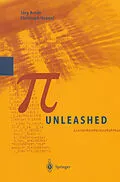In the 4,000-year history of research into Pi, results have never been as prolific as present. This book describes, in easy-to-understand language, the latest and most fascinating findings of mathematicians and computer scientists in the field of Pi. Attention is focused on new methods of high-speed computation.
Inhalt
1. The State of Pi Art.- 2. How Random is ??.- 2.1Probabilities.- 2.2 Is ? normal?.- 2.3 So is ? not normal?.- 2.4 The 163 phenomenon.- 2.5 Other statistical results.- 2.6 The Intuitionists and ?.- 2.7 Representation of continued fractions.- 3. Shortcuts to ?.- 3.1Obscurer approaches to ?.- 3.2 Small is beautiful.- 3.3 Squeezing ? through a sieve.- 3.4 ? and chance (Monte Carlo methods).- 3.5 Memorabilia.- 3.6 Bit for bit.- 3.7 Refinements.- 3.8 The ? room in Paris.- 4. Approximations for ?and Continued Fractions.- 4.1Rational approximations.- 4.2 Other approximations.- 4.3 Youthful approximations.- 4.4 On continued fractions.- 5. Arcus Tangens.- 5.1 John Machin's arctan formula.- 5.2 Other arctan formulae.- 6. Spigot Algorithms.- 6.1 The spigot algorithm in detail.- 6.2 Sequence of operations.- 6.3 A faster variant.- 6.4 Spigot algorithm for e.- 7.Gauss and ?.- 7.1 The ? AGM formula.- 7.2 The Gauss AGM algorithm.- 7.3 Schönhage variant.- 7.4 History of a formula.- 8. Ramanujan and ?.- 8.1 Ramanujan's series.- 8.2 Ramanujan's unusual biography.- 8.3 Impulses.- 9. The Borweins and ?.- 10. The BBP Algorithm.- 10.1Binary modulo exponentiation.- 10.2 A C program on the BBP series.- 10.3 Refinements.- 11. Arithmetic.- 11.1Multiplication.- 11.2 Karatsuba multiplication.- 11.3 FFT multiplication.- 11.4 Division.- 11.5 Square root.- 11.6 nth root.- 11.7 Series calculation.- 12. Miscellaneous.- 12.1 A ? quiz.- 12.2 Let numbers speak.- 12.3 A proof that ? = 2.- 12.4 The big change.- 12.5 Almost but not quite.- 12.6 Why always more?.- 12.7 ? and hyperspheres.- 12.8 Viète × Wallis = Osler.- 12.9 Squaring the circle with holes.- 12.10 An (in)finite funnel.- 13.The History of ?.- 13.1 Antiquity.- 13.2 Polygons.- 13.3 Infinite expressions.- 13.4 High-performance algorithms.- 13.5 The hunt for single ? digits.- Table: History of ? in the pre-computer era.- Table: History of ? in the computer era.- Table: History of digit extraction records.- 14. Historical Notes.- 14.1 The earliest squaring the circle in history?.- 14.2 A ? law.- 14.3 The Bieberbach story.- 15.The Future: ?Calculations on the Internet.- 15.1 The binsplit algorithm.- 15.2 The ? project on the Internet.- 16. ?Formula Collection.- 17. Tables.- 17.1 Selected constants to 100 places (base 10).- 17.2 Digits 0 to 2,500 of ? (base 10).- 17.3 Digits 2,501 to 5,000 of ? (base 10).- 17.4 Digits 0 to 2,500 of ? (base 16).- 17.5 Digits 2,501 to 5,000 of ? (base 16).- 17.6 Continued fraction elements 0 to 1,000 of ?.- 17.7 Continued fraction elements 1,001 to 2,000 of ?.- A. Documentation for the hfloat Library.- A.1 What hfloat is (good for).- A.2 Compiling the library.- A.3 Functions of the hfloat library.- A.4 Using hfloats in your own code.- A.5 Computations with extreme precision.- A.6 Precision and radix.- A.7 Compiling & running the ?-example-code.- A.8 Structure of hfloat.- A.9 Organisation of the files.- A. 10 Distribution policy & no warranty.
